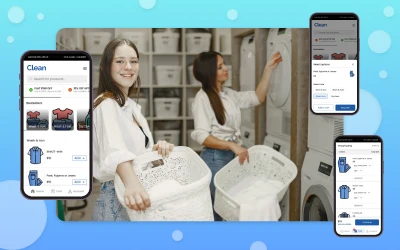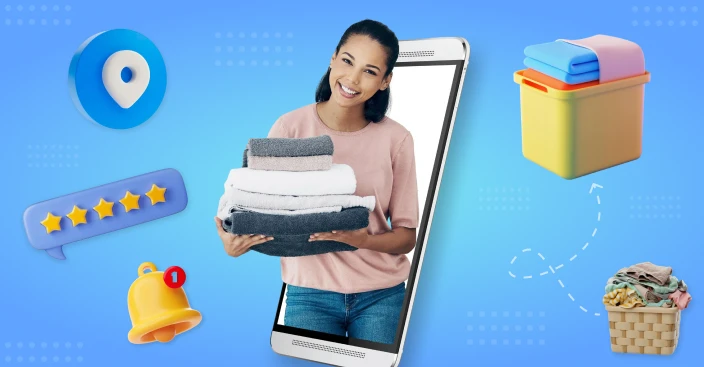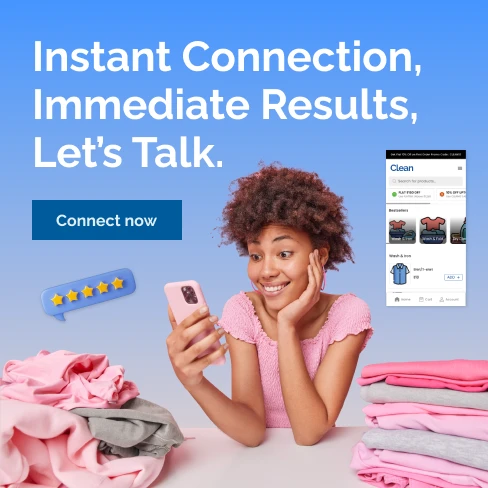The Changing Landscape of Laundry Businesses Through On-Demand Laundry Apps

With busy schedules all around, people these days barely have the time to come back home and complete all of their household chores. If they have the option to opt for an alternative that allows them to get these chores completed in the shortest possible period at a minimal cost, they would surely use the same to spend with their friends and family.
Among these household chores, the most cumbersome processes are cooking and doing the laundry. But the presence of alternatives to performing these chores has made lives more manageable.
These alternatives span the entire spectrum of on-demand services ranging from food delivery to laundry app services. The sector for on-demand food delivery services gained momentum primarily because it made people’s lives a little more convenient once they started using the app.
But the on-demand food delivery and transportation markets have now become saturated with a large number of players. At the same time, other sectors, such as online laundry delivery services have started attracting more and more new entrants.
Getting the laundry done is a task that requires some time and effort, especially for people who do not have washing machines. In such a case, people concentrate on usually getting their laundry done from the local laundryman. For services such as dry cleaning, people typically depend on washes for their expertise in dealing with materials that need more care.
But both these activities require the customer to physically visit these outlets, which the customer would ideally seek to avoid if they had an option to do so. With the emergence of on-demand laundry apps, customers can now outsource these activities as these apps also provide doorstep pickup as well as delivery options to the customers.
Under the on-demand model, all the customer has to do is to book a slot for availing the service by filling out the necessary details along with providing some specific instructions for the cleaning process. On completion of the payment process, the doorstep pickup can be scheduled as per the slots booked.
After the pickup process is over, the service process starts. Once that is completed, the goods are delivered to the customer’s doorstep. So the process spares the user of the hassle that they had to bear previously.
This simple model can wipe out several limitations that exist in the current market for laundry services. Swiggy and Zomato succeeded in implementing a marketplace model to create an online market space where buyers, as well as restaurants, could interact and place orders through these apps.
If such a marketplace can be created for local laundry service providers who will also generate more sales through the app, then it is beneficial to both the parties involved in the business. In such a model, the entrepreneur does not necessarily need to have a physical establishment or laundry equipment to operate the business.
This scenario also results in the entrepreneur spending the least amount of money in terms of investment and still solving a prevalent issue, thereby generating profits from the same. Since the number of jobs created also increases through such a business, it has a positive impact on the people.
Even entrepreneurs will be less reluctant to venture into such a business since the amount of capital involved is less, and there is no inventory involved in such a service.
For companies that already have a physical establishment that provides laundry services, venturing into such a business should be a cakewalk. These companies already have the required assets and equipment. All they need to do now is to set up a digital presence to attract customers through all the channels and not just through a single channel.
For different sets of entrepreneurs seeking to develop a mobile app for an on-demand laundry business, there exist different models which can cater to each one of their needs. These business models are core to the functioning of the app and the process through which these apps work.
Why should you invest in developing an on-demand laundry app?
As compared to the other businesses which operate in the domain of providing on-demand business solutions, this sector is not yet that saturated with other entrants. But considering the different essential aspects of building a business in such an industry, there is a good chance for these on-demand businesses to prosper in such a scenario.
Some of these aspects include:
- Business Model
- Utility
- Unique Features of the Service
Business models for the on-demand laundry app development landscape
The reason behind an on-demand application starting its operations is not always due to the existing business recognizing a need for expansion into the digital sphere of activity. This expansion can also arise out of a need for an online marketplace where sellers and buyers can interact with each other and avail services through the same.
Such a model gives the buyers several options to choose from, besides providing the seller access to a more extensive customer base. The three business models that these businesses usually operate through are:
The In-site Model:
In such a model, the company has several laundry establishments at various points in a particular specific region. In this model, there is no presence of a pickup or a delivery agent. The customers themselves drop off their clothes along with the cleaning instructions for the same at these designated places. Once this service is over, the clothes are delivered to the end-user.
This model faces the need for having its laundry stations and the entire business establishment, along with the assets, are owned by the entrepreneur. The amount of investment required for such a model is, therefore, on the higher side.
The On-site model:
This model is also meant for businesses that have been operational in the field of running its laundry businesses and have some physical retail establishments for the same. Most companies that face the need to go for an online business model to expand their customer base might opt for such a model.
Such a model provides flexibility for the order pickup and delivery processes as the customer can schedule them according to their convenience. Trained staff, professional pickup agents as well as excellent customer service are some of the prerequisites for adopting such a business model.
If this kind of a business model is followed, it provides the business with a higher chance of gaining new customers as well as retaining the existing ones by providing them superior service.
The Aggregator Model:
This kind of business model is usually adopted by startups that lack a brick-and-mortar presence and the necessary assets to operate a laundry app business independently.
These businesses have to rely on the creation of a marketplace through which different on-demand service providers would be able to provide their services or sell their goods.
This setup is beneficial to the businesses operating in the physical domain as it saves them from the hassle of building an app on their own just to expand their business. They are only required to pay a certain listing fee to get them listed on the app, after which they do not have to bear any additional charges for the same.
With each sale being recorded, a specific portion of the proceeds from the sale goes to the app developers. The transactions are usually handled by the admin teams of the aggregator firm, who deduct a specific portion as commission and then pays the sellers.
For users, having this kind of app helps them bypass the problem of installing too many apps that perform similar functions or provide the same types of on-demand services. Through such an app, a person can not only choose their favorite on-demand service provider but also compare the prices between other service providers as well through a single platform.
In the case of an aggregator model, the aggregator provides all the services under its brand. It is involved in the pricing of the products and also assures the quality of the services that are offered. Some of these aggregators are also responsible for providing the delivery personnel who provide the pickup and delivery services.
In the case of a marketplace economy, the owners of the laundries already have a large customer base with a good reach. If each of these owners refers their customers to use the app, the groups of people who might find it convenient to do so – especially the working professionals, will start opting for the services online.
In the marketplace model, the marketplace creator does not provide assurances about the quality of services that people might receive. Customers will have to rely on other people’s reviews when trying to use these services and select their service providers at their discretion. Reviews and ratings, thus, form a significant feature in these on-demand laundry service models.
Utility and Functionality that the App Provides to its Users
The utility of an app is one of the critical factors which determine its popularity in the business of developing an application. This utility comes in the form of the kind of benefits that the app can provide its users with.
The primary USP of such laundry applications is the fact that it can provide a particular service in a way that is cost-effective for the users to avail and also saves them a lot of time, which they can utilize in other ways. So the primary levels of functionality would include the provision of basic washing, drying, and pressing facilities, which can help avoid washing as a household chore.

The secondary level of functionality comes with the provision of value-added services such as dry cleaning or stain removal, and many more. This functionality also ties in with the ability to select the exact time of pickup and delivery that the people might find to be comfortable.
The third level of service offering comes with the option to customize an order through the use of a specific type of detergent, fabric conditioner, or provide toxin-free cleaning services.
This service can be done so that people can enjoy the exact look and feel of the service that has the familiarity of the service they avail at home but is of a higher quality.
All these factors tie in with the functionality that such an app can provide to its users. The continuous innovation that has taken place in the sphere of technology used for app development has enabled the mobile app development companies to build apps that provide all these features.
But app development companies should not primarily focus on building an app that is rich in features but is difficult for people to operate. The app interface should be simple enough that any technologically-challenged user can navigate through it with ease and be able to avail the necessary washing, folding, and pressing services.
Meanwhile, it should also have an option for the user to select advanced instructions for the treatment of different types of clothes, which would allow for further customization of the order. These customizations provide an added incentive to the customers who feel like going back to gain the same level of service through the app.
At the beginning of the app development process, a company can go in to provide the necessary services. It can keep on incorporating additional functions as and when required based on the feedback received from the users. These functions will help to save the company from incurring extra costs while running the business at the initial stage.
Unique Features of the Service:
Any mobile app that is operational in the on-demand service domain should conform to certain specific design standards that most other apps that operate in the same area have to fulfill. Any app development company that operates in the same sector has to be aware of such design standards.
Any app that is operational in the same field will have multiple features that can help the users gain utility from using the interface.
One of the basic features is a registration panel, which is common for both customers, administrative staff, laundry personnel as well as delivery staff. This panel would allow them to register on the apps using their social media accounts, email iDs, or mobile numbers, thereby allowing a faster registration process.
Next comes the service choices available to the customers. These include options to allow for the customization of the different services that are offered. This range of services can consist of washing preferences, specific treatments related to different materials, kinds of fabric, type of detergents used, and so on.
After choosing the services that these customers prefer along with the required customizations, a user can also schedule the pickup and delivery times for the order to be collected and delivered. These features form the delivery panel of the application.
In case the app has in-site operations, the customers may be allowed to choose the option of dropping off their laundry at these sites.
After this step, the customers will be provided with a break up of the costs that availing the service will entail. These costs are subject to the number of clothes as well as the customizations that are required to be made for each type of clothing.
In an aggregator model, the app interface should also allow the customer to choose the particular laundrymen that they prefer. This provision can enable them to select one of the laundrymen that they had previously availed services from, who had provided a superior quality of service. This feature would also allow them to add that laundry to their favorites list.
The next set of features should allow the customer to choose their most preferred mode of payment through the app. This process can be facilitated through the use of payment portals such as PayTM, Billdesk, PayPal, UPI gateways such as Google Pay or digital wallets.
Once the check-out process is done, the next feature, which is quite essential, is the order tracking option. This option provides the user with real-time updates about the order status, its location, the estimated time of delivery, etc.
In case the customer wants to cancel their orders, the app should also have an order cancellation feature that allows the customers to cancel their orders at the click of a button. This feature should also send a notification about the same to the pickup and the administrative staff.
Other features that the app might provide its users to build on the experience are providing updates about promotional offers through push notifications. Such a function can also inform the users about the status of their orders and also update them upon delivery of the order.
Customer reviews are quite important for apps that employ the marketplace model for their app interface. Here, customer reviews help the consumer to make their choices about the particular laundry service provider that they would want to choose.
These added features, along with an excellent customer support service with added benefits such as a cost calculator, can boost the downloads of the app.
The admin team should have a panel through which they will be able to view the previous order history of any customer. There should also be a pane that shows the real-time data recorded by the app and its analysis of the demographic details of the customers who are visiting these apps.
This kind of analytics pane gives an idea about the performance of the app in the market. Data analyzed through this feature tells the company about the type of customers that it should target with its ads.

For making the app more optimized for the delivery personnel, it should give them access to a route map to reach the customer in the shortest period. It should also allow them to keep track of their earnings and receive requests for pickup and drop-off.
The attractiveness of the app interface also helps to attract customers. For laundry applications, the color combination should comprise colors that the consumers associate with the attributes of being clean and pristine. All these features add to the customer’s experience of using the app.
Apart from the list of features that are more or less similar across all other apps that operate in the same domain, the company has to seek out its unique selling points (USPs) that can differentiate it from the competitors.
These USPs can be elementary features such as next-day delivery of the clothes or discounts on bulk orders. Excellent customer service can also be one of the features that help to convert a user into a loyal customer who keeps returning for the service experience.
The Apps in the On-Demand Domain Which Have Been Successful
Cleanly, now operating in 9 major cities in the US as of 2025, raised over $12 million in funding and currently processes over 1.5 million laundry orders annually. (Crunchbase, 2025)The key USPs of the app is their assurance to collect, wash, fold, and deliver the clothes within 24 hours of placing the order. It has all the basic features of the other on-demand laundry app platforms. It offers its users an option to take a snap of any stain that might require extra attention.
Apart from providing laundry services, the app also offers additional services such as dog walking and more. The main idea behind this app is to offer features that save time and reduce the hassle for the users besides ensuring timely delivery.
Rinse: This US-based startup has a funding of $23.5 million and provides laundry and dry cleaning services. It follows the typical service model through which a laundry app works – that is, once a customer has booked a slot, a rinse valet comes to pick up the clothes and also delivers them once the cleaning process is over.
With the development of a robust mobile app that can cater to all the service demands of the on-demand dry cleaning and laundry app market, it is possible to emerge as a competitor in this industry. But first, it is crucial to determine which kind of a business model might be the one that is most suitable for the business.
How does an on-demand laundry app work?
There are usually three stakeholders in the on-demand mobile app system platform. The first one is the admin team (in case of aggregator or marketplace models), the laundryman (who plays the role of the admin team in the on-site model), the delivery personnel, and the end-users.
The role of the app is to connect all the parties involved and ensure that the information reaches from one party to another, starting from the initiation to the end of the service.
The user’s journey starts with them downloading the application off the app store for both Android and iOS devices. After downloading, the customer journey begins through the following steps:
- The user registers themselves on the app by entering the necessary details
- Raise a request to avail laundry services depending on their demands – they can also specify the type of service as well as the kind of material – and makes the payment for the same
- The admin team receives the requests and accepts the order based on its feasibility
- The admin team checks the availability of the delivery personnel, books the time slot and sends an email and a text message confirming the timing of the pickup and the details of the pickup personnel
- On the designated date, the pickup guy collects the clothes from the customer and takes the clothes to the laundry
- After the completion of the service, the garments are returned to their owner by the designated delivery executive.
Future of the On-demand Industry for Laundry apps
The industry for on-demand laundry app services has shown considerable growth in recent years, fuelled by a section of career-oriented, fast-moving people with packed schedules. A platform that is high on performance is essential to formulate an on-demand, clustered, and scalable solution to the customers. According to a 2025 report by Grand View Research, the global on-demand laundry services market is projected to reach USD 40.2 billion by 2026, growing at a CAGR of 35.4% between 2024 and 2026.
The level of internet penetration in such a market is one of the primary parameters for the success of the app in the market for on-demand services. A continuous trend of joint families splitting into smaller nuclear families is also one reason for the rising demand in this sector.
Based on geographical data, This is possibly due to the highly advanced supply chains and greater internet accessibility .As of 2025, North America continues to lead the global on-demand laundry market, now accounting for 40.7% of the total market share, driven by tech adoption and urbanized lifestyle patterns.
The Asia-Pacific region, notably India and Southeast Asia, now holds 21.5% of the global on-demand laundry market in 2025. This growth is attributed to increased smartphone penetration, rising disposable incomes, and urban migration. (Source: Statista, 2025)
The increasing adoption of on-demand systems by commercial end-user segments such as hospitals and hotels as measures to cut costs has also made this sector a lucrative opportunity for investment.
According to a report published by Goldstein Research, the startup sector has exhibited a rising trend of angel or seed investors who seek to invest in such startups. Such a pattern makes it viable for companies to prosper in such competitive markets and also employ tactics that can improve their business models.
Most developed nations are equipped with greater internet penetration, improved logistics services and infrastructure, and access to devices that support such app downloads.
But this industry is also plagued by many problems such as a low return-on-investment and the due to narrow profit margins and a lack of skilled labor. There exists an additional need to provide discounts and promotional offers to keep up with the competitors in the business.
Moreover, the market is not mature enough for the users to realize the demand completely, unlike the on-demand industry for food delivery services. At present, these apps target a specific niche of customers, and the real momentum will only be gained when people across all demographics start using these apps.
These are some of the reasons why some of these on-demand laundry services such as Prim, Washio, and many more have been shut down. The primary reason behind such a shutdown has been due to having a wrong business model that could not earn them a stable position in the market based on the quality of service rendered and associated costs.
On-Demand App Development
The process of development of on-demand applications forms a critical role in such a process. As the number of apps that cater to the on-demand service sector increases, the competition among app development companies which are operating in the mobile app development business also increases.
More and more companies are flocking into this domain to help the app developers create a perfect app that can meet all the demands of the laundry app industry. Innovation in terms of app development languages, the presence of cloud servers to store such vast amounts of data makes the business scalable.
The cloud servers manage all communications related to the business through secured servers, which also helps to maintain data security. This added security also ties in with the use of software databases, which can change depending on the app requirements.
Other developments in the app construction domain talk about using technologies such as Twilio and Push.io to send push notifications to the users quickly. These are quite helpful as modes of marketing to reach the end-users.
GPS technologies, along with payment gateways, have streamlined the processes of order tracking as well as making payments through these apps. In-app analytical tools analyze the user statistics and also generate reports on the download and usage of these apps, helping them to find their target customers.
The app has to be optimized in a way that it quickly emerges when the users search for on-demand laundry applications on the app store. This optimization can be done through ensuring the app uses the optimal keywords in its description, focusing on improving its ratings on the app store – which can result in a more significant number of downloads.
The final factor that ensures that the app will attract users easily is how smoothly the app runs. If the app interface gives a premium feel without causing errors or glitches, then the user will be more inclined to use the app and refer it to other people as well.
Thus, it is essential to approach an app development company that can keep all these factors in mind while building an app that is suited to cater to the needs of the on-demand laundry industry.
Conclusion
The scenario for developing a laundry app for business is rapidly transforming every day. In such a dynamic atmosphere, it is vital for companies working in these sectors to keep themselves updated about the recent advancements in technology and supply chain processes.
These processes, along with broader internet penetration, would help to move this sector forwards in leaps and bounds. The industry for laundry apps has led to the evolution of how people do their laundry.
As more people with busy schedules rely on on-demand apps for laundry services, this sector is poised for tremendous growth in the future.
FAQs
 What is an on-demand laundry app?
What is an on-demand laundry app?
An on-demand laundry app is a mobile application that lets you schedule laundry or dry-cleaning services online. You can book a pickup, get your clothes washed, dried, and ironed, and have them delivered back to your doorstep.
 How does an on-demand laundry app work?
How does an on-demand laundry app work?
The process is simple:
- You register on the app.
- Choose the laundry or dry-cleaning service you need.
- Pick a date and time for pickup.
- A delivery person collects your clothes.
- Once cleaned, your clothes are delivered back to you.
 Why should I use a laundry app instead of my local laundry shop?
Why should I use a laundry app instead of my local laundry shop?
Laundry apps save time and effort. You don’t have to travel to drop off or pick up your clothes. You also get flexible scheduling, multiple service options, and the ability to track your order in real time.
 What business models are used in laundry apps?
What business models are used in laundry apps?
There are mainly three models:
- In-site model: You drop off and pick up your laundry from a fixed location.
- On-site model: The company handles both pickup and delivery.
- Aggregator model: A marketplace that lists different laundry providers so you can choose and compare services.
 Is it expensive to use an on-demand laundry app?
Is it expensive to use an on-demand laundry app?
No, the cost is usually affordable and depends on the type of service (basic wash, dry cleaning, ironing, stain removal, etc.). Many apps also offer discounts on bulk orders or special promotions.
 Can I choose detergents or special cleaning options?
Can I choose detergents or special cleaning options?
Yes, most apps let you customize your order. You can select detergents, fabric softeners, toxin-free cleaning, or request special care for delicate fabrics.
 What challenges might jewelry businesses face when using DAM?
What challenges might jewelry businesses face when using DAM?
Some common challenges include integrating DAM with existing systems, training staff to use it properly, and setting up consistent metadata (tags and categories). However, with good planning and expert guidance, these challenges can be managed.





